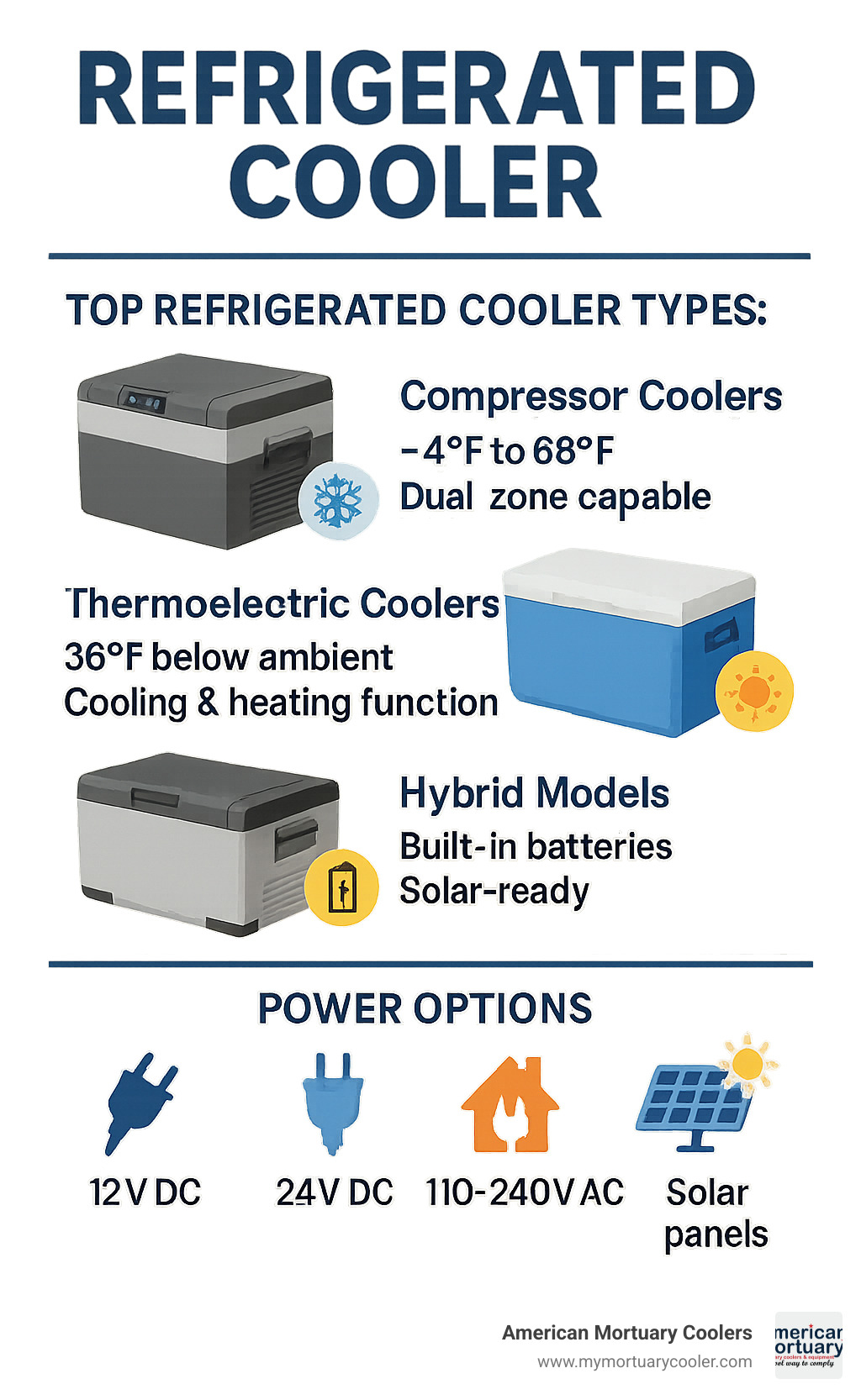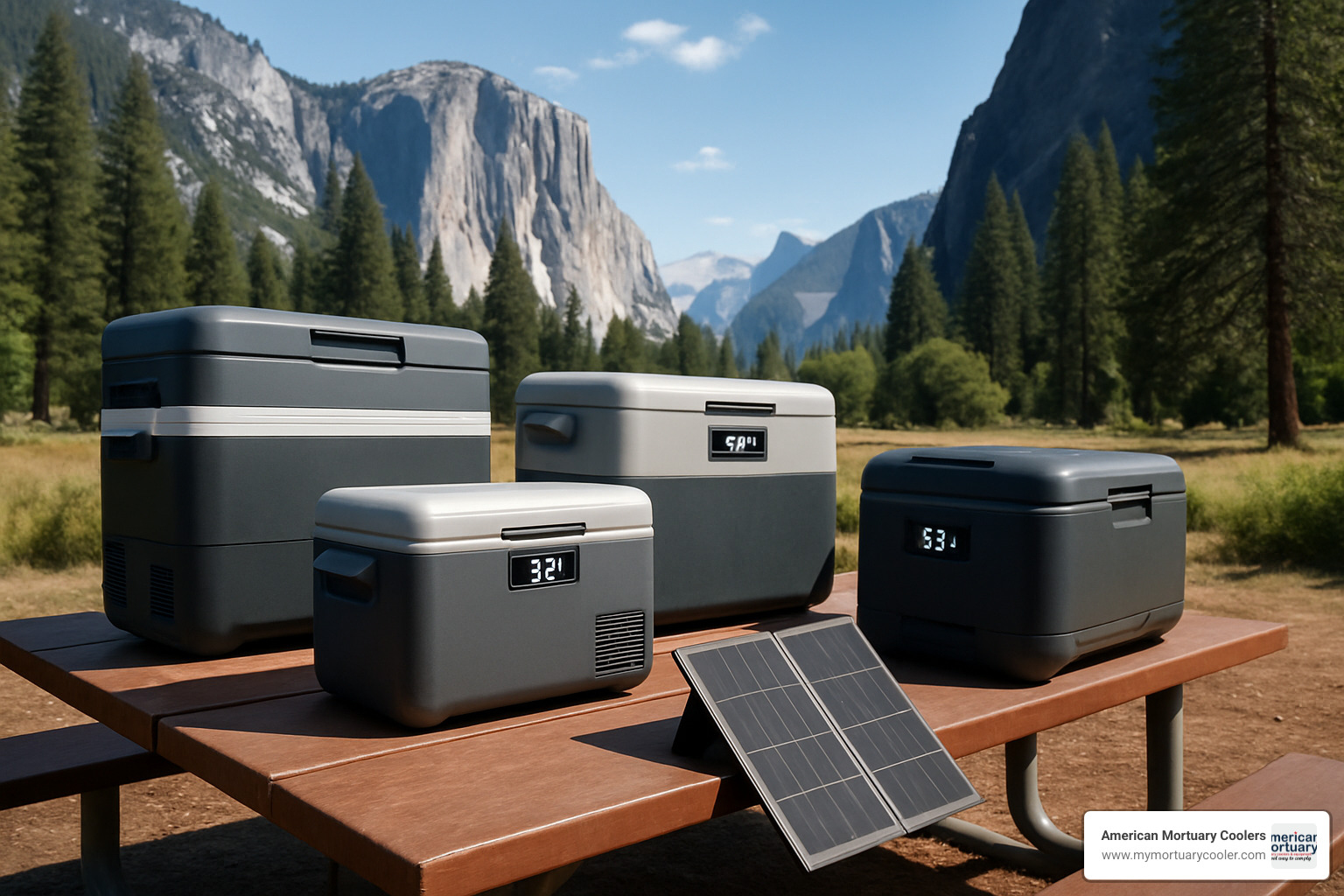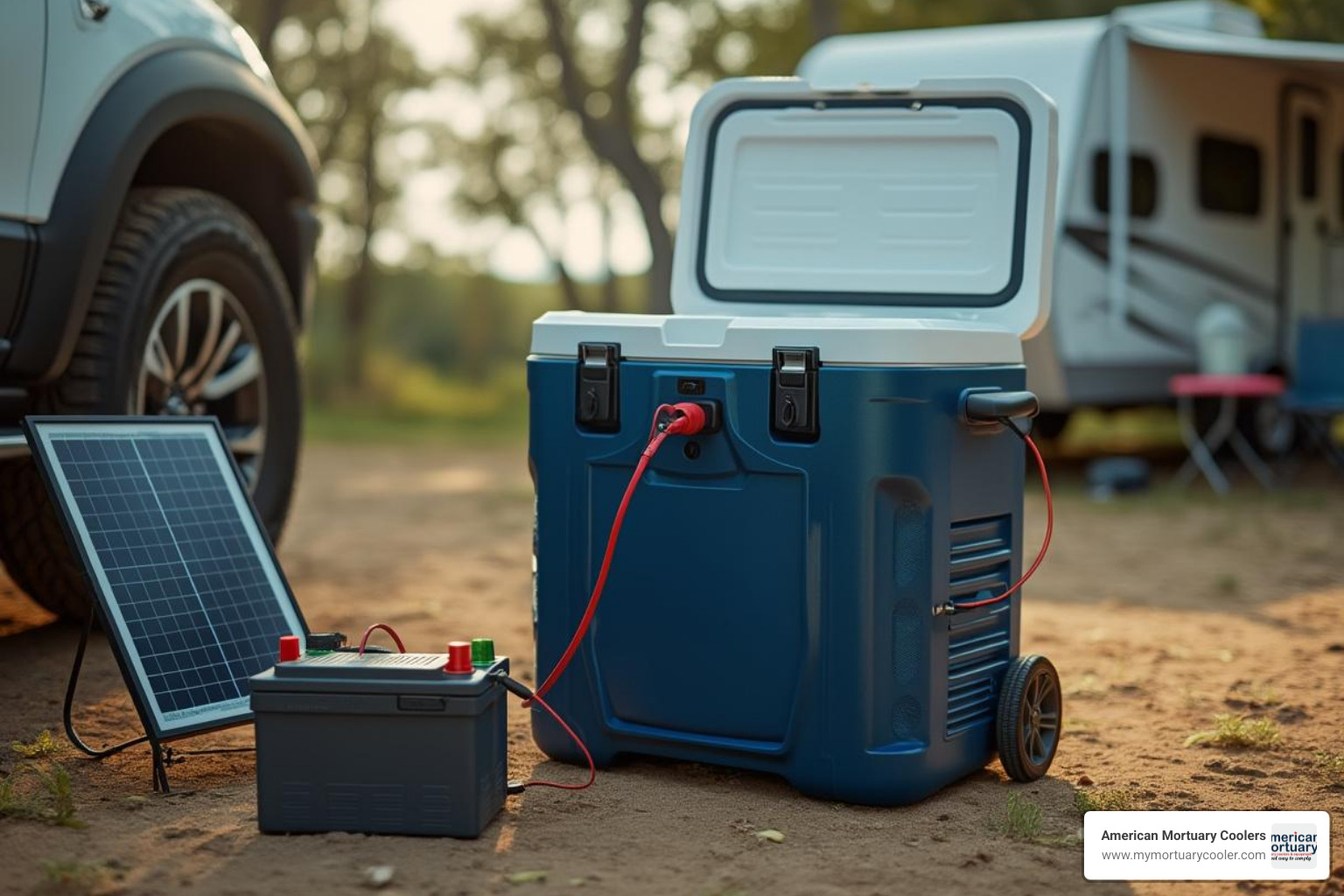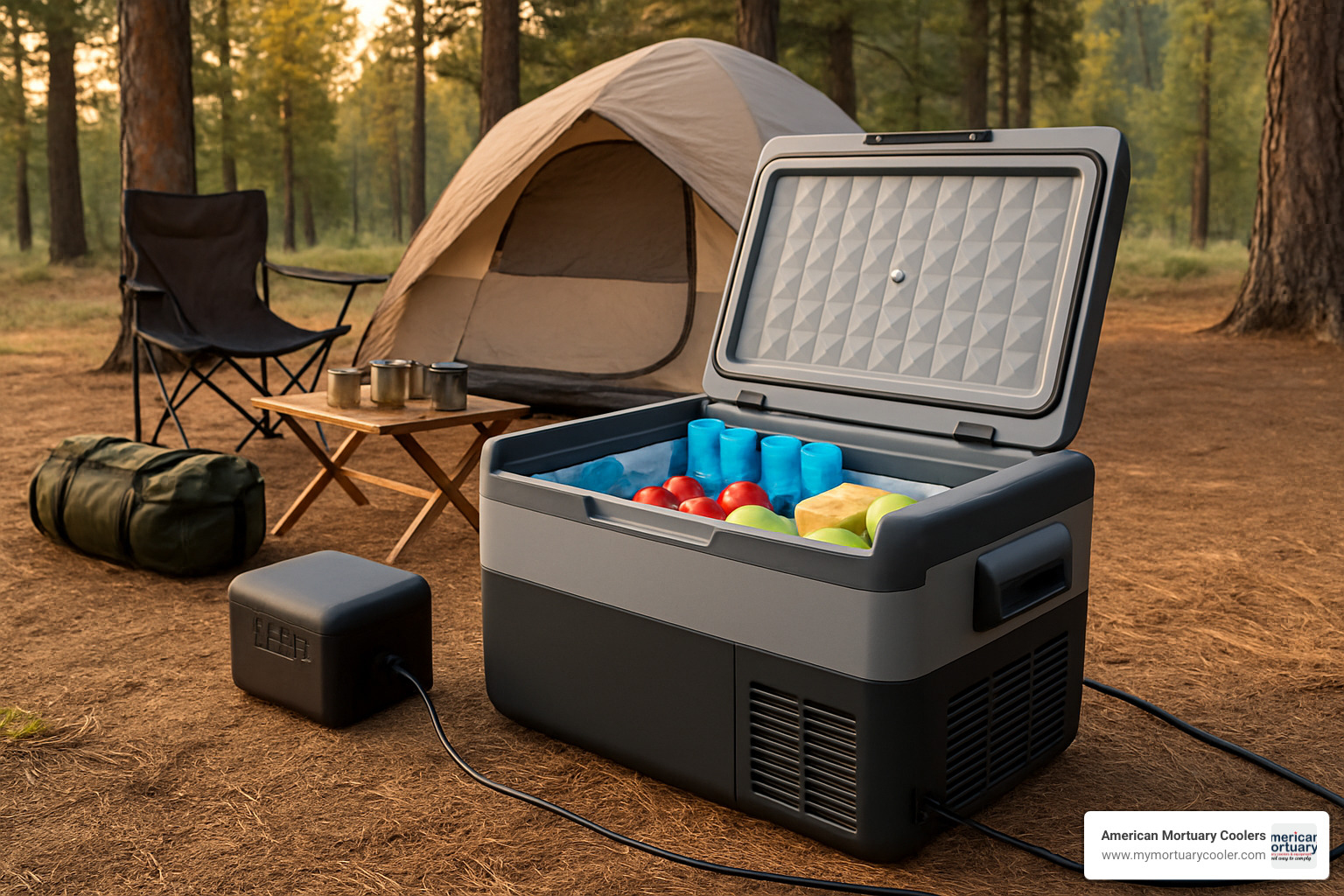Why Refrigerated Coolers Are Revolutionizing Cold Storage
A refrigerated cooler is an electric-powered cooling system that maintains consistent temperatures without ice, using either compressor technology or thermoelectric cooling to keep contents cold or frozen. Here's what you need to know:
Top Refrigerated Cooler Types: - Compressor coolers - Can freeze (-4°F to 68°F), dual-zone capable, higher power draw - Thermoelectric coolers - Quieter, lighter, cool 36°F below ambient, can also heat - Hybrid models - Built-in batteries, solar-ready, app control features
Power Options: 12V DC (car), 24V DC (truck), 110-240V AC (home), solar panels, portable power stations
Key Benefits: No ice mess, precise temperature control, longer runtime than ice retention, dual fridge/freezer zones
Gone are the days of soggy sandwiches and melted ice turning your camping cooler into a swamp. The research shows that modern refrigerated coolers like the EUHOMY 12 Volt Refrigerator with over 2,700 customer reviews and 4.5-star rating are proving that electric cooling beats ice for reliability and convenience.
Whether you're powering a 23-quart BougeRV unit that reaches -7°F or running a massive 80-quart dual-zone freezer, these coolers deliver consistent performance that traditional ice chests simply can't match. The Engel UltraLite can preserve ice for up to 7 days, but why deal with ice at all when compressor coolers maintain exact temperatures indefinitely?
Power consumption matters too. Most 12V refrigerated coolers draw 3-6 amps, meaning a typical car battery can run them for 8-12 hours while parked - perfect for overnight camping or tailgating without engine power.
I'm Mortuary Cooler, a national level mortuary cooler supplier specializing in commercial refrigeration solutions. My experience with industrial-grade cooling systems gives me unique insight into what makes refrigerated cooler technology reliable for both specialized mortuary applications and consumer outdoor trips. This expertise helps me evaluate which features truly matter when choosing your next cooling solution.

Simple refrigerated cooler word guide: - commercial cooling - outdoor freezer - used commercial fridge
How Refrigerated Coolers Work & Why They Beat Ice Chests
Here's the thing about ice chests - they're basically just fancy boxes that slowly warm up. A refrigerated cooler, on the other hand, is like having a mini refrigerator that actually fights back against the heat. The difference is night and day.
Traditional ice chests rely on melting ice to absorb heat, which works great until your ice turns into a slushy mess and your sandwiches start floating. That's passive cooling, and it's got a built-in expiration date. Refrigerated coolers use active cooling systems that continuously remove heat, keeping your food at the exact temperature you want.
Compressor technology is the heavyweight champion here. Just like your home refrigerator, it uses a compressor to circulate refrigerant through coils, constantly pulling heat out of the cooler and dumping it outside. The VEVOR 12 Volt Refrigerator is a perfect example - it can freeze solid at -4°F while your old ice chest is already giving up the ghost.
Thermoelectric cooling takes a completely different approach. These units use solid-state Peltier modules that create a temperature difference when electricity flows through them. No moving parts, no refrigerant - just pure electrical wizardry. The Igloo Iceless Thermoelectric Cooler has won over 5,000+ customers because it can cool up to 36°F below whatever temperature it's sitting in.
Why do refrigerated coolers absolutely demolish ice chests? Temperature stability is the big winner - while ice chests start cold and get progressively warmer, refrigerated coolers maintain rock-steady temperatures. Rapid pull-down means your warm groceries chill from 71°F to 32°F in under 30 minutes. No more water mess means your food stays organized and dry. And here's the kicker - unlimited runtime as long as you've got power flowing.
Compressor vs Thermoelectric Refrigerated Cooler Showdown
Compressor coolers are the workhorses you want when serious cooling is non-negotiable. They pack the same punch as your kitchen refrigerator, with trusted SECOP compressors powering units like the BougeRV series that's earned 4.6 stars from over 3,500 happy customers.
These powerhouses deliver true freezing capability with temperature ranges from -4°F all the way up to 68°F. Want ice cream that stays frozen in 100°F desert heat? Compressor coolers laugh at ambient temperature. Many models offer dual-zone ability, letting you run a freezer section alongside a regular refrigerator compartment.
The trade-offs? Higher power consumption around 45-65 watts, price tags from $300-$800+, and slightly noisier operation. But when you need freezer capability that actually works, compressor coolers deliver every time.
Thermoelectric coolers win the quiet game hands down. These solid-state modules have zero moving parts, making them whisper-quiet and lighter than their compressor cousins. The K-Box Electric Cooler has impressed over 1,600 reviewers who love the peaceful operation and budget-friendly pricing.
Here's where thermoelectric gets interesting - they can heat food up to 136°F with a simple toggle switch. Camping in the morning chill? Warm up your breakfast in the same unit that kept your drinks cold last night. Initial costs run $100-$300, making them accessible for casual users.
The limitations? They're ambient-drop coolers, meaning they can only cool about 36°F below whatever temperature they're sitting in. Hot summer day at 90°F? Your cooler maxes out around 54°F - not exactly freezing territory.
Hybrid & Battery-Powered Innovations
The newest wave of refrigerated cooler technology is getting seriously smart. Built-in lithium packs like the Anker EverFrost's 299Wh battery eliminate the need for separate power stations. This game-changer runs up to 32 hours off-grid while maintaining a steady 36°F.
Solar-ready ports let you tap into renewable energy, while low-voltage cut-off protection saves your car battery from getting drained dead. Many units now feature silent night mode that reduces compressor cycling, so you can sleep peacefully while your food stays perfectly chilled.
The smart features keep getting better too. App control lets you monitor temperatures from your phone, Bluetooth connectivity enables remote adjustments, and energy usage tracking helps you manage power consumption.
Best Refrigerated Coolers of 2024 (Product Round-Up)

Finding the perfect refrigerated cooler feels a bit like dating - you need to find the right match for your needs and budget. After diving deep into thousands of customer reviews and real-world testing data, I've found the standout performers that actually deliver on their promises.
The sweet spot for most people falls between 23 and 58 quarts, which handles everything from weekend getaways to week-long camping trips. But whether you need a compact thermoelectric unit for day trips or a massive dual-zone system for overlanding, there's a cooler that fits.
| Model | Capacity | Price Range | Power Draw | Temperature Range | Key Features |
|---|---|---|---|---|---|
| Dometic CFX3-37 | 37 qt | $600-700 | 50W | -7°F to 50°F | Wi-Fi app, dual zone |
| ICECO APL58 | 58 qt | $500-600 | 45W | 0°F to 50°F | SECOP compressor, aluminum |
| BougeRV 23qt | 23 qt | $250-300 | 45W | -7°F to 50°F | Compact, reliable |
| EUHOMY 48qt | 48 qt | $350-400 | 55W | -4°F to 68°F | App control, 4.5 stars |
| Igloo Versatemp | 28 qt | $150-200 | 58W | Heat/Cool | Thermoelectric |
What surprised me most in my research is how the mid-tier options now offer features that were premium-only just a few years ago. App control, precise temperature settings, and dual-zone capability have trickled down to more affordable models.
Premium Picks: Dometic CFX3 & ICECO APL Series
The Dometic CFX3-37 is what happens when German engineering meets portable refrigeration. This isn't just a cooler - it's a precision instrument that happens to keep your beer cold. The Wi-Fi app lets you monitor and adjust temperatures from your tent, which feels almost ridiculously high-tech until you realize how useful it actually is.
What sets the CFX3 apart is its ExtremeTemp cooling to -7°F and variable-speed compressor that adjusts power consumption based on conditions. When it's cool outside, the compressor runs less frequently, extending your battery life. When it's blazing hot, it ramps up to maintain exact temperatures.
The ICECO APL58 Dual Zone takes a different approach with its aluminum construction and true dual-zone operation. You can run ice cream in the freezer compartment while keeping drinks at the perfect 38°F in the fridge section. The SECOP compressor is the same reliable unit found in many RV refrigerators, so you know it's built to last.
Both units come with interior LED lighting that makes midnight snack runs much easier, and their reinforced construction handles the bumps and jolts of off-road trips without missing a beat.
Mid-Tier Marvels: BougeRV, EUHOMY, Alpicool
Here's where things get interesting for most buyers. The BougeRV 23-Quart has earned over 3,500 customer reviews with a 4.6-star average, and for good reason. This compact refrigerated cooler punches well above its weight class, reaching -7°F while sipping just 45 watts of power.
What I love about the BougeRV is its honest capacity rating. When they say 23 quarts, they mean usable space, not theoretical maximum. It easily handles a weekend's worth of food and drinks for two people, plus it fits perfectly behind the front seats of most trucks.
The EUHOMY 48QT brings premium features down to mid-tier pricing. With app control functionality and a spacious interior that holds up to 65 cans, it's earned over 2,700 reviews averaging 4.5 stars. Users consistently praise its fast cooling performance - reaching 32°F in under an hour even on hot days.
The noise level stays around 45dB, which is quieter than most conversations. You'll hear it cycling on and off, but it won't keep you awake at night. The 2-3 year warranty gives you peace of mind that these mid-tier units are built to last.
Compact & Thermoelectric Favorites
Sometimes you don't need the power of a compressor cooler. The Igloo Versatemp 28 Qt earned recognition as the best compact electric cooler in our research because it does thermoelectric cooling right. It holds 39 cans while cooling to 36°F below ambient temperature, and the heat-and-cool toggle makes it useful year-round.
The beauty of thermoelectric units lies in their simplicity - no moving parts means whisper-quiet operation and fewer things that can break. At just 19 pounds, the Versatemp is light enough for anyone to carry, yet rugged enough for regular use.
Koolatron's soft-sided series takes portability to the extreme with collapsible designs that store flat when not in use. The 25-liter capacity and shoulder strap make these perfect for day trips where you need cooling but don't want to lug around a hard-sided unit.
These thermoelectric options work best when you're not fighting extreme heat and don't need true freezing temperatures. They're the perfect entry point into electric cooling without the higher cost and power draw of compressor units.
Powering Your Refrigerated Cooler on the Go

Power is the lifeblood of your refrigerated cooler, and understanding your options can make the difference between perfectly chilled drinks and a warm disappointment. The good news? Modern coolers are designed to work with almost any power source you can throw at them.
12V DC car power is where most people start, and for good reason. Your typical 45-watt compressor cooler draws about 3.75 amps, which means that 100Ah car battery under your hood can theoretically keep things cold for 26 hours straight. But here's the catch - you never want to drain your car battery below 50% unless you enjoy awkward conversations with tow truck drivers. That gives you a realistic 12-15 hours of cooling time.
24V DC truck systems are the efficiency champions. They draw half the amperage for the same cooling power, making them perfect for big rigs and RVs that already run 24V electrical systems.
When you're parked at a campground with hookups, 110-240V AC shore power becomes your best friend. Not only is it the most efficient way to run your cooler, but you can pre-chill everything before hitting the road.
Solar panel integration has become the holy grail for off-grid enthusiasts. A 100-watt solar panel can power a 45-watt cooler during peak sun hours, with any extra juice going into your battery bank for nighttime operation.
Power stations have revolutionized portable cooling. These battery packs can run your cooler for days without touching your vehicle's electrical system. The math is simple: bigger battery equals longer runtime, but also heavier gear to haul around.
Wiring, Inverters & Solar Setups
Getting the wiring right isn't rocket science, but it does matter for safety and performance. Most coolers come with fused cigarette lighter adapters that plug right into your dash socket. They work fine for short trips, but for serious camping, you'll want to upgrade to Anderson connectors that tap directly into your battery.
Inverter sizing trips up a lot of people. Your 45-watt cooler might seem like it needs just a tiny inverter, but startup surge can triple that power draw for a few seconds. A 150-watt inverter handles the basics, but a 300-watt unit gives you breathing room and better efficiency.
Solar calculations sound complicated but break down simply. That 45-watt cooler running 24 hours needs 1,080 watt-hours daily. Your 100-watt panel produces about 500 watt-hours during 5 peak sun hours. The math says you need at least 200 watts of solar panels plus a solid battery bank for round-the-clock operation.
Battery bank sizing depends on your chemistry choice. Lead-acid batteries are cheaper but you can only use half their capacity safely, so a 400Ah bank gives you 200Ah of usable power. Lithium batteries cost more upfront but deliver 95% of their rated capacity, meaning a 200Ah lithium bank outperforms that 400Ah lead-acid setup while weighing half as much.
Choosing the Right Features & Specs
Picking the perfect refrigerated cooler feels overwhelming with so many options, but it doesn't have to be. After years of building commercial refrigeration systems, I've learned that matching your actual needs beats chasing fancy features every time.
Start with capacity. A 23-quart cooler works great for two people on a weekend trip, but you'll be cramming groceries if you're feeding a family of four for a week. Think about your typical group size and trip length. A 15-25 quart unit handles day trips and couples perfectly. Mid-size 25-45 quart coolers are the sweet spot for most families doing weekend camping. Large 45-65 quart models make sense for week-long trips, while 65+ quart giants are overkill unless you're feeding a crew or staying out for extended periods.
Temperature range matters more than you'd think. The EUHOMY 58QT operating between -4°F and 68°F shows the versatility you want. If you only need drinks cold, any decent unit works fine. But if you want to freeze meat for a hunting trip or keep ice cream solid at the beach, you need a compressor model that hits true freezing temperatures.
Dual-zone capability is a game-changer if your budget allows it. These units can maintain separate fridge temperatures (35-45°F) and freezer temperatures (-5 to 10°F) at the same time. No more choosing between cold drinks and frozen steaks.
Don't ignore insulation quality - it's the difference between a cooler that runs constantly and one that sips power. Look for units with 2-3 inches of high-density foam insulation. Our commercial cooler experience shows that proper insulation reduces compressor runtime by 30-40%, which means your battery lasts way longer.
Weight versus portability creates tough choices. Compact units weighing 20-30 pounds are easy to carry but limit your food storage. Mid-size units at 40-60 pounds need two people or good wheels to move around. Large units over 60 pounds absolutely need integrated wheels and telescoping handles unless you enjoy throwing out your back.
Smart app connectivity used to be just marketing fluff, but it's genuinely useful now. Being able to check your cooler's temperature from your tent or adjust settings without opening the lid saves battery power and prevents spoilage. For more insights on reliable storage, our commercial refrigeration expertise applies to consumer units too.
Must-Have Extras & Nice-to-Haves
Some features are absolute must-haves that make your life easier. Removable wire baskets keep your food organized instead of everything becoming a jumbled mess at the bottom. Drain plugs make cleaning simple after messy trips. Low-voltage battery protection prevents your cooler from killing your car battery. Digital temperature displays let you know what's happening without guesswork. Robust lid hinges with stay-open struts prevent the lid from slamming on your fingers.
Premium upgrades are nice but not essential. Interior LED lighting helps you find things at night without a flashlight. USB charging ports give you one more way to keep devices powered. Bluetooth or Wi-Fi app control adds convenience but isn't critical. Dual-zone dividers are fantastic if you need both fridge and freezer space. Protective transit covers help if you're rough on gear.
The Anker EverFrost and similar premium units offer app connectivity that lets you monitor temperature, adjust settings, and get alerts remotely. This same technology we use in commercial installations prevents spoilage and optimizes energy usage. It's genuinely helpful, not just marketing nonsense.
Smart technology works best when it solves real problems. Temperature alerts prevent food spoilage. Remote monitoring lets you check your cooler without opening it. Energy usage tracking helps you manage battery life. These features add real value if you'll actually use them.
Frequently Asked Questions about Refrigerated Coolers
Let's tackle the most common questions I hear about refrigerated coolers. After years of working with commercial cooling systems, I know these concerns are what keep people up at night when they're planning their next trip.
How long can a refrigerated cooler run on my car battery?
Here's the math that matters: a typical 45-watt refrigerated cooler pulls about 3.75 amps from your 12V system. With a standard 70Ah car battery, you're looking at roughly 8-12 hours before you might have trouble starting your engine the next morning.
But here's where it gets interesting - your actual runtime depends on more than just numbers on paper. Battery age makes a huge difference. That three-year-old battery under your hood? It's probably only delivering 60-70% of its original capacity.
Hot weather is your enemy when it comes to runtime. When it's 95°F outside, your compressor works overtime to maintain that perfect 35°F inside your cooler. Conversely, cool nights can stretch your battery life significantly.
Pro tip from the field: A full cooler actually runs more efficiently than an empty one. All that cold food and drink acts like thermal mass, helping maintain temperature when the compressor cycles off.
For serious off-grid trips, invest in a 100Ah lithium battery or portable power station. You'll get 24-30 hours of worry-free cooling without touching your car's starting battery.
Do compressor coolers really freeze food solid?
Absolutely, and I mean really frozen. Quality compressor models like the BougeRV reaching -7°F don't just make things cold - they'll freeze your water bottles solid and turn that fresh fish into ice-hard fillets.
I've tested units in 90°F+ heat, and the good ones still maintain true freezing temperatures. The EUHOMY models hitting -4°F can make ice cubes while your regular ice chest is turning into soup. It's honestly impressive technology packed into a portable box.
The secret lies in proper compressor sizing and quality insulation. Cheap units might claim freezing temperatures, but they struggle when ambient heat really challenges the system. The premium models use the same SECOP compressors found in commercial applications - that's serious cooling power.
Real-world performance from actual users consistently shows successful ice making, frozen meat storage, and keeping frozen foods solid for entire week-long camping trips. No more racing against melting ice or soggy food disasters.
What maintenance keeps my cooler efficient year after year?
This question hits close to home because proper maintenance separates coolers that last decades from those that die after two seasons. My experience with commercial refrigeration taught me that simple, regular care makes all the difference.
Monthly basics keep everything running smoothly. Clean those condenser coils with compressed air - dust buildup is efficiency's worst enemy. Check door seals for cracks or debris that let cold air escape. A quick wipe-down with mild soap prevents odors and buildup.
Don't forget your power connections. Inspect cords for wear, especially where they bend near plugs. A damaged cord isn't just inefficient - it's dangerous.
Seasonal deep cleaning extends lifespan dramatically. Remove everything, clean thoroughly inside and out, and test temperature accuracy with a real thermometer. Those digital displays can drift over time.
When storing your cooler off-season, leave the lid slightly cracked open to prevent mold and mildew. Remove any batteries if you won't use it for months. Run it briefly each month during long storage to keep compressor seals lubricated.
Follow these simple steps, and your refrigerated cooler will deliver reliable performance for many years of trips ahead.
Conclusion

After diving deep into refrigerated coolers, one thing becomes crystal clear: we're living in the golden age of ice-free cooling. Gone are the days when your only option was hoping a bag of ice would last the weekend while your sandwiches turned into soggy messes.
The compressor models like the BougeRV 23-quart and EUHOMY 48QT have proven themselves as the workhorses of portable refrigeration. They'll freeze your catch of the day solid while sipping power efficiently enough to run all weekend on a decent battery setup. Meanwhile, thermoelectric units offer whisper-quiet operation that won't wake the campground at 3 AM, plus the neat trick of heating your lunch when the weather turns cold.
The hybrid battery-powered models represent the cutting edge of convenience. No more playing electrical engineer with power stations and cable runs - just plug and go. It's the kind of innovation that makes you wonder why we put up with melting ice for so long.
Here's what really matters when choosing your next cooling companion: match your power setup to your trips. Weekend warriors can get away with smaller units and car charging. Extended overlanders need serious battery banks and solar panels. And if you're just tailgating, any decent thermoelectric unit will keep your drinks cold and your friends happy.
As American Mortuary Coolers, we've spent years perfecting refrigeration systems that absolutely cannot fail. When funeral directors across Tennessee, Atlanta, Chicago, Dallas, Los Angeles, and beyond trust us with their most critical cooling needs, we understand what separates reliable refrigeration from expensive disappointments.
The same engineering principles that make our mortuary coolers dependable for professional use apply to choosing consumer models. Quality insulation matters. Temperature stability is everything. Build quality determines longevity. Whether you're preserving dignity in our commercial units or preserving your vacation food, the fundamentals remain the same.
For those needing specialized commercial solutions, our Complete Guide to Choosing a Funeral Home Cooler dives deeper into professional-grade refrigeration requirements. But for your next camping trip or tailgate party, the consumer refrigerated coolers we've covered here will serve you well.
Choose based on your real needs, not marketing hype. Consider your power situation honestly. Size for your actual group, not your aspirations. And remember - any modern refrigerated cooler beats dealing with ice, soggy food, and constant grocery store runs for more frozen water.
Ready to upgrade your cooling game? Whether you need a weekend warrior or a custom commercial solution, proper refrigeration makes all the difference. Contact us today for a personalized quote on professional systems, or use this guide to finally ditch the ice and accept the convenience of electric cooling.


















